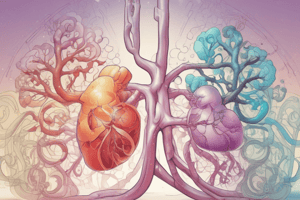Podcast
Questions and Answers
What is the principal effect of acidosis on the body?
What is the principal effect of acidosis on the body?
- Stimulation of the CNS
- Depression of the CNS through a decrease in synaptic transmission (correct)
- Stimulation of the respiratory center
- Stimulation of the kidneys
What is the primary way that the kidneys compensate for acidosis?
What is the primary way that the kidneys compensate for acidosis?
- Excreting lactic acid
- Retaining hydrogen ions
- Excreting bicarbonate ions
- Eliminating hydrogen ions and retaining bicarbonate ions (correct)
What is the term for a high level of CO2 in the blood?
What is the term for a high level of CO2 in the blood?
- Hypercapnia (correct)
- Hyperventilation
- Hypoventilation
- Metabolic acidosis
What is the term for the excess of carbonic acid in the blood?
What is the term for the excess of carbonic acid in the blood?
What is the normal range of bicarbonate ion concentration in the blood?
What is the normal range of bicarbonate ion concentration in the blood?
What is a possible cause of chronic respiratory acidosis?
What is a possible cause of chronic respiratory acidosis?
What is the normal pH range of human extracellular fluids?
What is the normal pH range of human extracellular fluids?
What is the primary source of acid in the body?
What is the primary source of acid in the body?
What is the role of buffer systems in acid-base regulation?
What is the role of buffer systems in acid-base regulation?
What is the effect of acid-base imbalance on hormonal activity?
What is the effect of acid-base imbalance on hormonal activity?
What is the primary mechanism of respiratory regulation of acid-base balance?
What is the primary mechanism of respiratory regulation of acid-base balance?
What is the term for the process by which the kidneys reabsorb or secrete acids to maintain acid-base balance?
What is the term for the process by which the kidneys reabsorb or secrete acids to maintain acid-base balance?
What is the primary function of the bicarbonate buffer system in the body?
What is the primary function of the bicarbonate buffer system in the body?
Which of the following is a characteristic of the phosphate buffer system?
Which of the following is a characteristic of the phosphate buffer system?
What is the result of increased H+ secretion in the proximal tubule?
What is the result of increased H+ secretion in the proximal tubule?
What is the term for the body's response to acid-base imbalance?
What is the term for the body's response to acid-base imbalance?
What is the role of the respiratory system in regulating pH?
What is the role of the respiratory system in regulating pH?
Flashcards are hidden until you start studying
Study Notes
Acid-Base Balance
- pH range: 0-14; acidic if pH < 7, basic if pH > 7
- Human extracellular pH: 7.35-7.45, intracellular pH: 7.0
- Acid-base balance affects electrolytes (Na+, K+, Cl-) and hormonal activity
Sources of Acids and Bases
- Acids come from food, metabolic processes, and cellular metabolism (CO2 production)
- Bases are secreted in the stomach and duodenum, and produced in the kidneys
Control of Acid and Base
- Buffer systems: take up or release H+ as conditions change
- Buffer pairs: weak acid and base, exchange strong acid or base for a weak one
- Body buffering systems: bicarbonate, phosphate, protein, and chemical buffers
Bicarbonate Buffer
- Maintains 20:1 ratio: HCO3:H2CO3
- Sodium bicarbonate (NaHCO3) and H2CO3
Phosphate Buffer
- Major intracellular buffer
- H+ + HPO42- → H2PO4 + OH-
Protein Buffer
- Works in blood and interstitial fluid (including hemoglobin)
- Carboxyl group gives up H+, amino group accepts H+
- 27 amino acids have side chains that can buffer H+
Respiratory System
- Exhales CO2, regulates pH by changing rate and depth of breathing
- Can eliminate large amounts of acid, converse and produce bicarbonate ions
- Most effective regulator of pH
Renal Acid Secretion
- H+ secretion occurs at the proximal tubule, distal tubule, and collecting duct
- Increase H+ reabsorbs 1 HCO3- back to the blood
Acid-Base Disorders
- pH < 7.35 is acidosis, pH > 7.45 is alkalosis
- Body response to acid-base imbalance is called compensation
Studying That Suits You
Use AI to generate personalized quizzes and flashcards to suit your learning preferences.




